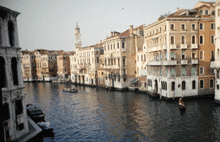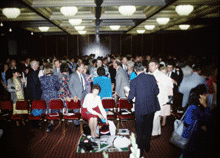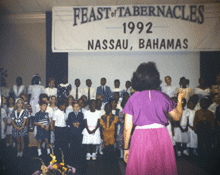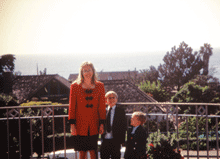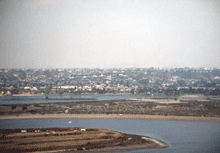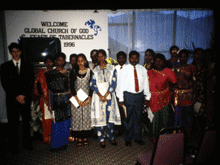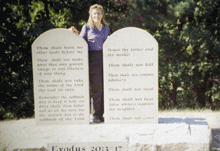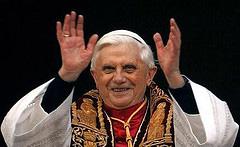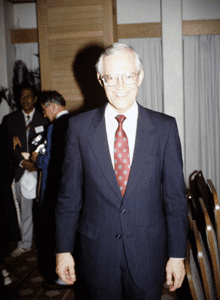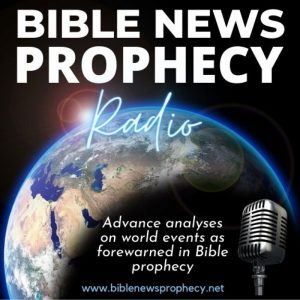Jehovah’s Witnesses and 1914
Sunday, September 30th, 2007By COGwriter
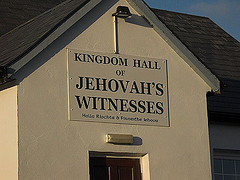
While the COGs rarely own church buildings, Jehovah’s Witnesses normally do.
Jehovah’s Witnesses Position of Its Modern History
Here is what the Jehovah’s Witnesses teach about their modern history:
THE modern history of Jehovah’s Witnesses began more than a hundred years ago. In the early 1870’s, a rather inconspicuous Bible study group began in Allegheny, Pennsylvania, U.S.A., which is now a part of Pittsburgh. Charles Taze Russell was the prime mover of the group. In July 1879, the first issue of the magazine Zion’s Watch Tower and Herald of Christ’s Presence appeared. By 1880 scores of congregations had spread from that one small Bible study into nearby states. In 1881 Zion’s Watch Tower Tract Society was formed, and in 1884 it was incorporated, with Russell as president. The Society’s name was later changed to Watch Tower Bible and Tract Society…
THE YEAR 1914
A crucial time was drawing close. In 1876 the Bible student Charles Taze Russell contributed the article “Gentile Times: When Do They End?” to the Bible Examiner, published in Brooklyn, New York, which said on page 27 of its October issue, “The seven times will end in A.D. 1914.” The Gentile Times is the period referred to in another Bible translation as “the appointed times of the nations.” (Luke 21:24) Not all that was expected to happen in 1914 did happen, but it did mark the end of the Gentile Times and was a year of special significance.
The radio was used extensively in the 1920’s and 1930’s. By 1933 the Society was using 403 radio stations to broadcast Bible lectures. Later, the use of the radio was largely replaced by increased house-to-house visits by Witnesses with portable phonographs and recorded Bible talks. (Their Modern Development and Growth. Jehovah’s Witnesses Official Web Site. Published in 2000. Copyright © 2006 Watch Tower Bible and Tract Society of Pennsylvania. http://www.watchtower.org/library/jt/article_02.htm 07/09/07)
One modern historical difference is that the JWs moved away from electronic media about the same time that the COGs embraced it. The COGs do not consider 1914 to be nearly as significant as the JWs do.
Based upon discussions I have had with individual witnesses, it seems that the Jehovah’s Witnesses seem to teach that after the apostles an apostasy set in (that is true), that somehow some true believers remained (that is true), but that it really does not know who or where the true church was until the 1800s. The historical foundation for the JWs is weak (those who do not know where they came from are not likely to know where they are going either–JWs and non-COG types should ponder that). Hence the JWs tend to have a gap in history from around the end of the first century (the “full apostasy” per the JWs occurred in the fourth century, but I have not seen them attempt to trace themselves through leaders after those listed in the New Testament until the nineteenth century) to the mid-late nineteenth century. This differs from the COG.
Two articles that discuss the COGs throughout history would include History of Early Christianity and The Churches of Revelation 2 & 3.
Some Contradictions Related to 1914
Unlike the Jehovah’s Witnesses, the COGs do not believe that the final appointed time (which is the subject of Daniel 11:27,29, 35) nor the great tribulation (Matthew 24:21) began in 1914 (nor do the COGs teach that either has yet begun).
The Jehovah’s Witnesses however teach:
Without a doubt the ‘horsemen of the Apocalypse’ with their wars, food shortages, and disease epidemics have been cutting down large numbers of the human family since 1914.—Revelation 6:3-8…
What were the consequences for the human family? The prophecy continues: “Woe for the earth and for the sea, because the Devil has come down to you, having great anger, knowing he has a short period of time.” Yes, Satan knows that his system is nearing its end, so he is doing everything he can to turn humans against God before he and his world are put out of the way. (Revelation 12:12; 20:1-3) How debased those spirit creatures are because they misused their free will! How awful conditions have been on earth under their influence, especially since 1914! (How We Know We Are in “the Last Days”. Jehovah’s Witnesses Official Web Site. Published in 1992. Copyright © 2006 Watch Tower Bible and Tract Society of Pennsylvania. http://www.watchtower.org/library/dg/article_09.htm 07/23/07).
When Jesus was on earth, he proved that he would be a kind, just, and perfect Ruler. When he returned to heaven, he was not enthroned as King of God’s Kingdom right away. (Hebrews 10:12, 13) In 1914, Jehovah gave Jesus the authority He had promised him. Since then, Jesus has ruled in heaven as Jehovah’s appointed King.—Daniel 7:13, 14…As soon as Jesus became King, he threw Satan and his wicked angels out of heaven and down to the locality of the earth. That is why things have become so bad here on earth since 1914. (Revelation 12:9, 12) (What Is the Kingdom of God? Jehovah’s Witnesses Official Web Site. Published in 1996. Copyright © 2006 Watch Tower Bible and Tract Society of Pennsylvania. http://www.watchtower.org/library/rq/article_06.htm 07/23/07).
The time that God has allowed for humans to experiment with self-government is about to end. In fulfillment of Bible prophecy, his Kingdom was established in the heavens in 1914 with Jesus Christ as its King. # Shortly, it will crush and put an end to all human governments.—Daniel 2:44 (Why Does God Allow Us to Suffer? Jehovah’s Witnesses Official Web Site. Appeared in The Watchtower January 1, 2003. Copyright © 2006 Watch Tower Bible and Tract Society of Pennsylvania. http://www.watchtower.org/library/w/2003/1/1/article_02.htm 07/23/07).
…when Jesus spoke of today’s troubled system and “the sign” of its approaching destruction, he added, “This generation will by no means pass away until all these things occur.” Some, at least, of the generation that saw the “beginning of pangs of distress” in 1914 will live to see Paradise restored on earth. (Matthew 24:3-8, 34) (Education for Entering Paradise. Jehovah’s Witnesses Official Web Site. Published in 1986. Copyright © 2006 Watch Tower Bible and Tract Society of Pennsylvania. http://www.watchtower.org/library/lmn/article_11.htm 07/23/07).
Bible prophecy shows that appointed time came in 1914 C.E…For some 35 years prior to 1914, The Watchtower (now the most widely distributed religious magazine on earth) had been calling attention to 1914 as a year marked in Bible prophecy…However, if the heavenly government was established in 1914, why is there all this distress on earth? It is Satan the Devil who is responsible. When Christ received Kingdom power, his first act was to wage war on Satan in the invisible heavens. As a result, Satan, “who is misleading the entire inhabited earth,” was hurled with his angels down to the vicinity of the earth. Knowing that his destruction draws near, he stirs up great trouble on earth. It is “woe for the earth and for the sea, because the Devil has come down to you, having great anger, knowing he has a short period of time.”—Revelation 12:7-9, 12. (The Perfect Government of Peace. Jehovah’s Witnesses Official Web Site. Published in 1986. Copyright © 2006 Watch Tower Bible and Tract Society of Pennsylvania. http://www.watchtower.org/library/lmn/article_10.htm 07/22/07)
One source claimed that JW literature states that Jesus began “his invisible rule over the earth in 1914” (The Truth Shall Make You Free, p. 300. Cited at carm.org), and though I have not seen that precise quote, it could be consistent with the above claims.
But if so, this would seem to contradict their official belief that “Satan is invisible ruler of world”.
However, the JW written position seems to be that what is happening now is that Satan has been thrown down to earth since 1914, even though the Father gave Jesus the kingdom rulership then.
But the Bible and the COGs teach that the great tribulation that Revelation discusses is 3 1/2 years long and that period ends with Christ’s return (some feel it is possibly seven). What the Jehovah’s Witnesses seem to teach is that amount of the time from Satan being sent to the earth in 1914 and until Christ returns has been from over 93 years thus far (hence this seems to contradict their translation of Revelation 12 that Satan’s great anger is for “short period of time“). Also, the expression that Jesus mentioned about a particular “generation” would suggest that the timeframe probably could not be something like 100 years. The Jehovah’s Witnesses are clearly in error on many of their 1914 points.
Perhaps, since the Witnesses cited Revelation 12, it would be helpful to see the time period it actually mentions:
13 Now when the dragon saw that it was hurled down to the earth, it persecuted the woman that gave birth to the male child. 14 But the two wings of the great eagle were given the woman, that she might fly into the wilderness to her place; there is where she is fed for a time and times and half a time away from the face of the serpent (NWT).
A “time and times and half a time” is 3 1/2 years, not over 93 years (and by the time Jesus comes, it will likely have been over 100 years). Three and one half years makes a lot more sense for that short period of time.
Additionally, the Jehovah’s Witnesses seem to define shortly as within a timeframe apparently less than one year as they have also written:
Satan and the demons are now severely restricted. They can no longer materialize as they apparently once could. Shortly after the establishment of God’s Kingdom in the hands of Christ in 1914, they were cast down to the vicinity of the earth.—Revelation 12:7-9 (THE DEVIL More Than Just Superstition. Jehovah’s Witnesses Official Web Site. Appeared in The Watchtower September 1, 2001. Copyright © 2006 Watch Tower Bible and Tract Society of Pennsylvania. http://www.watchtower.org/library/w/2001/9/1/article_02.htm 07/23/07).
So since the JWs teach that Satan was thrown down in 1914 and that this was shortly after Jesus received the Kingdom in 1914, it makes no sense that they teach that the short time that Satan was thrown down for is at least 93 years.
Since the JWs seem to teach that Jesus received “Kingdom power” in 1914, this sort of reminds me of what the Seventh-day Adventists (SDA) and other Adventists called the great disappointment (when Adventists were disappointed that Jesus did not come when they thought He would). After the “great disappointment”, Ellen Harmon (who became Ellen White) essentially taught that Jesus came not to the earth, but to a sanctuary and that this began a time of investigative judgment (this, thus was how they explained the error in the Advent–not that their date was wrong, but that would happened was misunderstood).
One critic of the Jehovah’s Witnesses has claimed:
Russell adopted many of his doctrines from the Seventh-Day Adventists, but the JWs began to emphasize door-to-door evangelism and literature distribution after Russell’s death and subsequent leadership assumption by Joseph Franklin Rutherford (Jehovah’s Witnesses: Christian or Cult?* Biblical Discernment Ministries – Revised 11/01. http://www.rapidnet.com/~jbeard/bdm/Cults/jw.htm).
There are a couple of reasons that I included the above. One is that since the SDAs formed (as essentially originally affiliating with the COG as a COG subgroup-though it was a little larger than the COG when the split later occurred) just before the Jehovah’s Witnesses did and the Jehovah’s Witnesses have several doctrines that are similar to those of the COGs, it does make sense that C. Russell was probably familiar with SDA doctrine and kept those he felt were appropriate. The other reason is that I was told a long while ago by a JW member that their church essentially came out of the Millerite movement (the Millerites thought that Jesus would return in 1844-1846) in the early to mid 1800s–and this is also true of many SDAs and probably even some in the COG back then. Hence, this may explain some of the doctrinal similarities. (More on the history of the COGs in the 1800s can be found in the article The Sardis Church Era; more on the SDAs can be found in the article SDA/COG Differences.)
Both the JWs and COGs believe that there have been true Christians throughout history. However, a major difference is that the COGs believe that they can identify many of them essentially throughout history, while the Jehovah’s Witnesses do not attempt to do that. There was also nothing in the JW official website that provided earlier history than I was able to locate when I last looked.
Three articles of possibly related interest may include:
Similarities and Differences Between the Jehovah’s Witnesses and the Churches of God Both groups have some interesting similarities, but many major differences. Would you like information on how to deal with Jehovah’s Witnesses?
The Churches of Revelation 2 & 3 Do they matter? Most say they must, but act like they do not. This article contains some history about the Church of God (sometimes referred to as the continuation of Primitive Christianity) over the past 2000 years.
Location of the Early Church: Another Look at Ephesus, Smyrna, and Rome What actually happened to the primitive Church? And did the Bible tell about this in advance?
